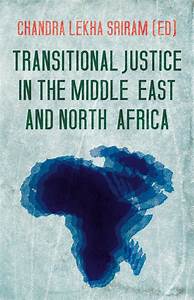Transitional Justice in the Middle East and North Africa
Transitional Justice in the Middle East and North Africa Reviewed by: Elham Kazemi, PhD student of Political Science, University of California, Irvine The uprisings known as the “Arab Spring” started in Tunisia in December 2010 and soon engulfed the whole Middle East and North Africa (MENA). Although each country in the region had a different experience of transition, most of them grappled with the question of transitional justice (TJ). Despite limited experiences with TJ also prior to the Arab Spring, TJ in MENA has been generally understudied. Transitional Justice in the Middle East and North Africa is an edited volume aiming to fill this gap. Part I of the book focuses on the core challenges and gaps in the TJ literature while drawing on the experiences in MENA. Three important issues stand out: First, more research is needed on what is expected from TJ initiatives. Chandra Sriram discusses three goals generally attributed to TJ – retribution, deterrence, victim-centered justice, and societal effects – and their pitfalls. Susan Waltz questions the assumed link between TJ and human rights, while Ibrahim Fraihat and Bill Hess examine the peace vs. justice dichotomy as often assumed incompatible goals of TJ. Second, assessing the impact of TJ is another challenge fraught with methodological problems. As an illustration, Waltz examines the limitations of CIRI Index and PTS which are usually used to assess human rights performance. Third, “whose” rights should TJ strive to address? There is an emphasis on local ownership in the TJ literature. Given that the “local” includes various and often contradictory perceptions and expectations, more research is needed on how TJ can be responsive to the diverse demands “from below.” The uprisings in MENA also put economic and social justice on the TJ agenda. The expansion of the rights traditionally addressed by TJ brings other challenges to the fore.
The last chapter in this part focuses on Tunisia as the only successful democratic transition in the region and demonstrates the politicization of TJ in the country which showed itself in heated debates over the boundary and scope of TJ. All in all, part I poses more questions than answers. Part II sheds light on some specific aspects of TJ in MENA. Chapter 6 focuses on gender in Tunisia. Showing how the experiences of female Islamist prisoners were sidelined in the Truth and Dignity Commission (IVD), the authors emphasize the necessity of TJ initiatives to incorporate women’s narratives. In Chapter 7, Thomas DeGeorge, discusses martyrdom as an important element of memorialization in TJ experiences in Algeria, Morocco, and Tunisia. While in Algeria references to martyrdom led to political and societal divisions, in the latter two countries, it showed a potential to resolve political divisions. The next chapter examines political exclusion in Libya. The authors discuss the trajectory of TJ in Libya and argue that it was mainly used as a one-sided and partial measure to eliminate political opponents. Part II concludes with a discussion of the truth commissions in Morocco (IER) and Bahrain (BICI). The procedural limitations of both mechanisms – i.e. neither could identify perpetrators – limited their impact. Despite such limitations, IER achieved more success by including former regime opponents while BICI was established in the absence of a political settlement. The question remains on how to draw lessons from these experiences for TJ more broadly. The chapters in Part III offer a thick case study of Egypt. Given that by all accounts, TJ did not materialize in Egypt, it is not clear why this country is chosen for a detailed case study. In Chapter 10, Judy Barsalou demonstrates how memorialization and collective memory as part of the TJ “toolkit” became politicized and in fact, sharpened political divisions in Egypt. The next chapter focuses on the challenges of judicial reform. Although the Egyptian judiciary was considered by many to be independent, Sahar Aziz argues that it is more appropriate to call it “a hybrid of ‘thin’ rule of law and rule by law” (p. 210). In fact, in post-revolutionary Egypt, the judiciary was deeply entrenched in the “deep state” and impeded the political transition. The concluding chapter deals with another aspect of institutional reform in Egypt – the security sector reform and the causes of its failure, especially following the military coup against the Morsi government in 2013. Throughout the book, three important lessons are emphasized in the context of TJ in MENA: First, stalled or incomplete political transitions, as in Egypt, pose hurdles and limit the success of TJ. Second, TJ has the potential of being politically manipulated and used for consolidation of power and elimination of political rivals. Third, a holistic and hybrid approach to TJ is more likely to achieve the desired ends. |



